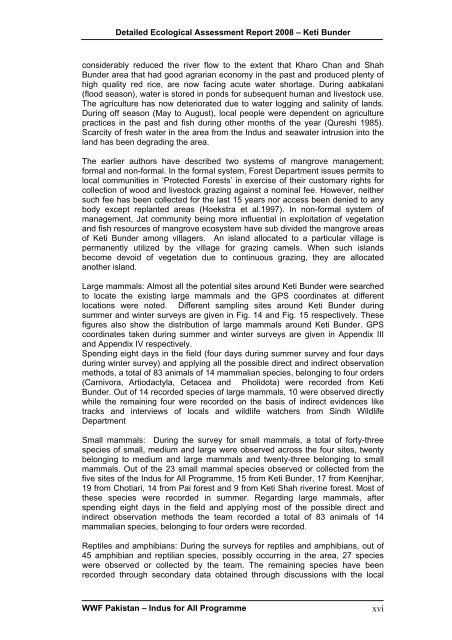Disclaimer note - WWF - Pakistan
Disclaimer note - WWF - Pakistan
Disclaimer note - WWF - Pakistan
Create successful ePaper yourself
Turn your PDF publications into a flip-book with our unique Google optimized e-Paper software.
Detailed Ecological Assessment Report 2008 – Keti Bunder<br />
considerably reduced the river flow to the extent that Kharo Chan and Shah<br />
Bunder area that had good agrarian economy in the past and produced plenty of<br />
high quality red rice, are now facing acute water shortage. During aabkalani<br />
(flood season), water is stored in ponds for subsequent human and livestock use.<br />
The agriculture has now deteriorated due to water logging and salinity of lands.<br />
During off season (May to August), local people were dependent on agriculture<br />
practices in the past and fish during other months of the year (Qureshi 1985).<br />
Scarcity of fresh water in the area from the Indus and seawater intrusion into the<br />
land has been degrading the area.<br />
The earlier authors have described two systems of mangrove management;<br />
formal and non-formal. In the formal system, Forest Department issues permits to<br />
local communities in ‘Protected Forests’ in exercise of their customary rights for<br />
collection of wood and livestock grazing against a nominal fee. However, neither<br />
such fee has been collected for the last 15 years nor access been denied to any<br />
body except replanted areas (Hoekstra et al.1997). In non-formal system of<br />
management, Jat community being more influential in exploitation of vegetation<br />
and fish resources of mangrove ecosystem have sub divided the mangrove areas<br />
of Keti Bunder among villagers. An island allocated to a particular village is<br />
permanently utilized by the village for grazing camels. When such islands<br />
become devoid of vegetation due to continuous grazing, they are allocated<br />
another island.<br />
Large mammals: Almost all the potential sites around Keti Bunder were searched<br />
to locate the existing large mammals and the GPS coordinates at different<br />
locations were <strong>note</strong>d. Different sampling sites around Keti Bunder during<br />
summer and winter surveys are given in Fig. 14 and Fig. 15 respectively. These<br />
figures also show the distribution of large mammals around Keti Bunder. GPS<br />
coordinates taken during summer and winter surveys are given in Appendix III<br />
and Appendix IV respectively.<br />
Spending eight days in the field (four days during summer survey and four days<br />
during winter survey) and applying all the possible direct and indirect observation<br />
methods, a total of 83 animals of 14 mammalian species, belonging to four orders<br />
(Carnivora, Artiodactyla, Cetacea and Pholidota) were recorded from Keti<br />
Bunder. Out of 14 recorded species of large mammals, 10 were observed directly<br />
while the remaining four were recorded on the basis of indirect evidences like<br />
tracks and interviews of locals and wildlife watchers from Sindh Wildlife<br />
Department<br />
Small mammals: During the survey for small mammals, a total of forty-three<br />
species of small, medium and large were observed across the four sites, twenty<br />
belonging to medium and large mammals and twenty-three belonging to small<br />
mammals. Out of the 23 small mammal species observed or collected from the<br />
five sites of the Indus for All Programme, 15 from Keti Bunder, 17 from Keenjhar,<br />
19 from Chotiari, 14 from Pai forest and 9 from Keti Shah riverine forest. Most of<br />
these species were recorded in summer. Regarding large mammals, after<br />
spending eight days in the field and applying most of the possible direct and<br />
indirect observation methods the team recorded a total of 83 animals of 14<br />
mammalian species, belonging to four orders were recorded.<br />
Reptiles and amphibians: During the surveys for reptiles and amphibians, out of<br />
45 amphibian and reptilian species, possibly occurring in the area, 27 species<br />
were observed or collected by the team. The remaining species have been<br />
recorded through secondary data obtained through discussions with the local<br />
<strong>WWF</strong> <strong>Pakistan</strong> – Indus for All Programme xvi

















